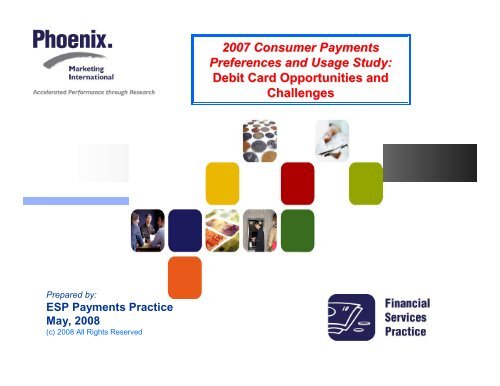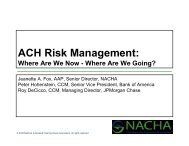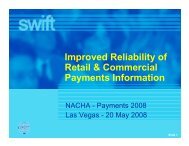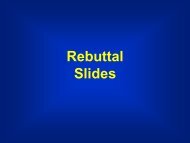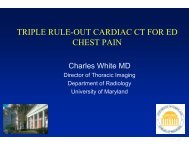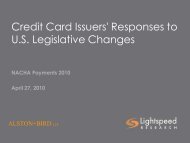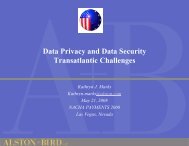Debit Card Opportunities and Challenges
Debit Card Opportunities and Challenges
Debit Card Opportunities and Challenges
Create successful ePaper yourself
Turn your PDF publications into a flip-book with our unique Google optimized e-Paper software.
2007 Consumer Payments<br />
Preferences <strong>and</strong> Usage Study:<br />
<strong>Debit</strong> <strong>Card</strong> <strong>Opportunities</strong> <strong>and</strong><br />
<strong>Challenges</strong><br />
Prepared by:<br />
ESP Payments Practice<br />
May, 2008<br />
(c) 2008 All Rights Reserved
Methodology<br />
<br />
<br />
Phoenix Marketing International’s ESP Payments Practice completed the<br />
data collection of its annual consumer payments study in June 2007. The<br />
study was conducted online with slightly more than 2000 consumers. The<br />
study is nationally representative of the online U.S. population, controlled<br />
to approximate census counts by age, income, gender, <strong>and</strong> census<br />
division. Additionally, the population was controlled by credit card<br />
ownership.<br />
The study covered multiple payment areas, but had a strong focus on debit<br />
card issues. This report covers consumer preferences, attitudes, <strong>and</strong> usage<br />
(both current <strong>and</strong> future intentions) of debit cards. It also looks at debit’s<br />
relationship to other payment methods, in particular, credit cards.<br />
ESP Payments Practice
Summary <strong>and</strong> Conclusions<br />
Roughly threefourths of the U.S. population has a debit card –a<br />
percentage that is stable. Overwhelmingly, these cards are card<br />
association br<strong>and</strong>ed. In contrast to credit cards, most consumers typically<br />
have just one debit card, placing it by default at ‘top of wallet’for debit.<br />
The relative stability of consumers’primary bank accounts, with their tie<br />
to debit cards, means that consumers are unlikely to switch debit cards<br />
simply due to a ‘better offer’as some consumers do with credit cards.<br />
Slightly more than onethird of debit cardholders keep larger balances in<br />
their accounts than they would otherwise due to the active use of their<br />
debit cards.<br />
Less than onethird of consumers’primary credit cards are with their<br />
primary bank. As debit card use increases, transactional activity with a<br />
customer’s primary bank increases. <strong>Debit</strong> activity creates the opportunity<br />
to drive customer wallet share <strong>and</strong> loyalty.<br />
<strong>Debit</strong> card usage will continue to experience strong growth. Pointofsale<br />
transactions will grow, but PIN debit in particular has growth potential at<br />
walkup centers <strong>and</strong> for recurring bill payments.<br />
ESP Payments Practice
ESP Payments Practice<br />
<strong>Debit</strong> <strong>Card</strong> <strong>and</strong> Credit <strong>Card</strong> Usage
<strong>Debit</strong> <strong>Card</strong> Use Causes Some Consumers to<br />
Maintain Larger Account Balances<br />
• Many consumers hold multiple credit cards. Some of these cards remain inactive, but some consumers<br />
switch between cards for different types of purchases. This is not the case with debit card transactions.<br />
Threefourths of consumers hold just one debit card, tied to their primary bank account.<br />
• To some extent, debit card usage has replaced check writing. But debit is also replacing other forms of<br />
payment, including cash <strong>and</strong> credit cards. For this reason, increased debit card transactional activity is<br />
requiring cardholders to hold larger bank account balances to draw upon with debit card usage.<br />
Size of Bank Account Balance Due to <strong>Debit</strong> <strong>Card</strong> Use<br />
“Use of my debit card causes me to keep a larger balance in that bank account than I<br />
would otherwise”<br />
Base: <strong>Debit</strong> <strong>Card</strong>holders<br />
35%<br />
23%<br />
All<br />
27%<br />
Income:<br />
>$100k<br />
ESP Payments Practice<br />
Agree<br />
(Keep larger Balance)<br />
Strongly Agree<br />
“Top 2 Box”<br />
(Keep larger Balance)
Shift from Credit to <strong>Debit</strong> <strong>Card</strong>s Will Continue<br />
<br />
<br />
<strong>Debit</strong> card transaction volumes continue to grow, replacing check <strong>and</strong> cash usage, <strong>and</strong> slowing the<br />
growth of credit card transactions. The impact on credit card usage due to debit usage is strong –nearly<br />
half of respondents agree that they will use debit instead of credit over the next three years, double the<br />
percentage that disagree.<br />
The shift to debit card usage is in part accompanied by a decrease in credit card usage for some<br />
consumers. The percentages expecting decreases in both forms of debit is low, <strong>and</strong> is nearly three times<br />
less than the percentage expecting a decrease in credit card usage.<br />
Intended Use of <strong>Debit</strong> <strong>and</strong> Credit <strong>Card</strong>s<br />
“Over the next three years, I will use my debit card more <strong>and</strong> my credit card less often.”<br />
45%<br />
22%<br />
ESP Payments Practice<br />
Strongly<br />
Agree<br />
Base: All consumers<br />
Strongly<br />
Disagree
Reasons for Selecting <strong>Debit</strong> <strong>Card</strong>s <strong>and</strong><br />
Credit <strong>Card</strong>s Differ<br />
• While consumers often use debit cards as a replacement for their previous use of cash or checks, debit<br />
card use also intersects with their selection of credit cards. Credit cards are often used to buy goods <strong>and</strong><br />
services –often higher priced items on credit. Conversely, debit cards are often used to avoid buying<br />
items on credit, as consumers report using debit cards to help control their spending.<br />
Main Reasons For<br />
Using <strong>Debit</strong> <strong>Card</strong>s<br />
Main Reasons For<br />
Using Credit <strong>Card</strong>s<br />
Helps Control<br />
Spending<br />
29%<br />
Rewards/Points<br />
11%<br />
Cash or Check<br />
Replacement<br />
47%<br />
No Other Options<br />
More Convenient/Faster<br />
8%<br />
6%<br />
More Secure<br />
11%<br />
Use For Higher Priced Purchases<br />
17%<br />
Habit<br />
2%<br />
Nearing Credit<br />
<strong>Card</strong> Account<br />
Limits<br />
3%<br />
Allow To Buy Now <strong>and</strong> Pay Later<br />
Don't Like To Carry Cash<br />
15%<br />
26%<br />
Other<br />
10%<br />
Other<br />
15%<br />
ESP Payments Practice<br />
Base: <strong>Debit</strong> <strong>Card</strong>holders
ESP Payments Practice<br />
Security Issues with <strong>Card</strong> Usage
Signature <strong>and</strong> PIN Security Concerns Are Equal<br />
<br />
<br />
<strong>Card</strong> <strong>and</strong> card number thefts have heightened security concerns with cards, <strong>and</strong> security concerns are<br />
higher for debit cards than with credit cards. <strong>Debit</strong> cards tie directly to customers bank accounts <strong>and</strong><br />
funds are removed within a few days, versus credit cards, where charges are billed to be paid after<br />
customer review.<br />
Consumers are equally concerned with PIN <strong>and</strong> signature debit used at retail locations. Less than onethird<br />
say they are not at all concerned with the security on their debit cards.<br />
Attitudes on Security of <strong>Debit</strong> <strong>Card</strong> Transactions:<br />
PIN v. Signature<br />
“Using an debit card with a PIN at a<br />
retail location.”<br />
23%<br />
28%<br />
“Using an debit card with a signature (no<br />
PIN) at a retail location.”<br />
22%<br />
30%<br />
ESP Payments Practice<br />
Very<br />
Concerned<br />
Not at all<br />
Concerned<br />
Very<br />
Concerned<br />
Not at all<br />
Concerned
Internet <strong>Card</strong> Transaction Concerns Remain<br />
High<br />
<br />
Nearly onethird of consumers are very concerned with using a debit card for Internet purchasing, <strong>and</strong><br />
onefourth have the same concern with credit card usage. Concerns are heightened by high profile media<br />
reports of store databases being hacked, <strong>and</strong> by use of stolen credit card numbers for Internet purchases,<br />
even though the card numbers are often stolen in the offline world.<br />
Attitudes on Security of Internet <strong>Card</strong> Transactions<br />
“Using a credit card at a store on<br />
the Internet.”<br />
26%<br />
26%<br />
“Using a debit card at a store on the<br />
Internet.”<br />
31%<br />
20%<br />
Very<br />
Concerned<br />
ESP Payments Practice<br />
Not at all<br />
Concerned<br />
Very<br />
Concerned<br />
Not at all<br />
Concerned
ESP Payments Practice<br />
<strong>Debit</strong> <strong>Card</strong>s <strong>and</strong> Bill Payment
More Consumers Want to Use <strong>Debit</strong> <strong>Card</strong>s<br />
than Credit <strong>Card</strong>s to Pay Bills<br />
<br />
<br />
More than onethird of consumers say that they will pay more bills electronically if they could use their<br />
debit cards. Large billers are increasingly accepting both credit <strong>and</strong> debit cards for payment to respond to<br />
consumer dem<strong>and</strong>, but some billers are reluctant to add what they perceive as higher processing cost<br />
methods.<br />
Some consumers prefer to pay by credit card, often to garner reward benefits. But since consumers have<br />
typically paid bills from their checking accounts, debit cards drawn from the same accounts are less of a<br />
behavior change than is a switch to credit cards. Fifty percent more consumers (36% to 24%) report that<br />
they would increase bill payments with debit cards (over credit cards) if they could.<br />
Attitudes on <strong>Card</strong> Use for Bill Payment<br />
“I would pay more bills electronically if I<br />
could pay with my debit card.”<br />
36%<br />
20%<br />
“I would pay more bills electronically if I<br />
could pay with my credit card.”<br />
24%<br />
33%<br />
Strongly<br />
Agree<br />
ESP Payments Practice<br />
Strongly<br />
Disagree<br />
Base: All consumers<br />
Strongly<br />
Agree<br />
Strongly<br />
Disagree
<strong>Debit</strong> <strong>Card</strong>s Are the Preferred <strong>Card</strong> Type<br />
For Paying Bills<br />
• With billers increasingly providing the option to pay bills with both credit <strong>and</strong> debit cards, consumers can<br />
select which card type to use for this purpose. When asked what type of card they would prefer to use if<br />
using a card to make a bill payment, consumers selected debit cards over credit cards by nearly a 5to2<br />
ratio.<br />
Preferred <strong>Card</strong> for Paying Bills<br />
“If I were to use a card to pay a bill, I would prefer to use . . .”<br />
Base: <strong>Card</strong>holders (<strong>Debit</strong> or Credit)<br />
49%<br />
21%<br />
14%<br />
16%<br />
ESP Payments Practice<br />
<strong>Debit</strong> <strong>Card</strong> Credit <strong>Card</strong> No<br />
Preference<br />
Would Not<br />
Use <strong>Card</strong> To<br />
Pay Bill
Younger, Moderate Income Consumers<br />
Strongly Prefer <strong>Debit</strong> to Credit for Bill Pay<br />
<br />
The preference for debit cards over credit cards to pay bills is strongest among middle aged <strong>and</strong> lowerincome<br />
consumers. Older consumers, <strong>and</strong> those with incomes above $100,000 are evenly divided in their<br />
preference among the two card types.<br />
Attitudes on Future <strong>Debit</strong> versus Credit <strong>Card</strong> Use for Bill Payment<br />
“I would pay more bills electronically if I could use my debit card.”<br />
44%<br />
36%<br />
“I would pay more bills electronically if I could use my credit card.”<br />
38%<br />
36%<br />
36%<br />
33%<br />
34%<br />
32%<br />
26%<br />
26%<br />
22%<br />
21%<br />
17%<br />
24%<br />
18% 19%<br />
22%<br />
27%<br />
1824 2534 3542 43 61 62+ $100k
<strong>Debit</strong> <strong>Card</strong>s Used for Walkup <strong>and</strong><br />
Telephone Bill Payments<br />
ESP Payments Practice
Despite the growth of new payment channels <strong>and</strong> the movement to electronic payment methods, 25<br />
percent of consumers report having made an inperson payment at a walkup center in the past month.<br />
<br />
<br />
Checks <strong>and</strong> Cash Account for Most Walkup<br />
Payments<br />
While people who make walkup payments are often thought to be unbanked, checks are used as often<br />
as cash to make payments at walkup sites.<br />
Among other payment methods, debit cards are used more often than credit cards, by a threetoone<br />
ratio. PIN debit is used twice as often as is signature debit, reflecting the methods accepted by<br />
providers.<br />
Payment Method Used for Walkup Payments<br />
“Most recent payment”<br />
42% 42%<br />
Cash<br />
ESP Payments Practice<br />
Check<br />
8%<br />
PIN<br />
debit<br />
card<br />
4%<br />
Signature<br />
debit card<br />
3%<br />
Credit<br />
card<br />
2%<br />
Other<br />
Base: Consumers Who Made<br />
Walkup Payment in Past Year
One in Five Consumers Make Telephone Bill<br />
Payments<br />
<br />
<br />
Consumers continue to make use of the telephone to pay bills. This is often the fastest way to make a<br />
last minute payment to stop a discontinuation of service.<br />
<strong>Card</strong> payments account for more than onehalf of all bill payments made by telephone. Of these card<br />
payments, debit cards account for nearly 80 percent of the total. Cash <strong>and</strong> paper checks dominate the<br />
walkup center payment environment, but these methods are not accepted by telephone.<br />
Percentage of Consumers Who Make Telephone Payments<br />
Telephone Bill Payment Made in Past Year<br />
Does Not Make<br />
Telephone Bill<br />
Payments<br />
79%<br />
21%<br />
Does Make Telephone<br />
Bill Payments<br />
ESP Payments Practice
STAR ® Bill Payment Service<br />
Melissa Santora<br />
STAR ® Network Product Management<br />
© 2008 First Data Corporation. All Rights Reserved.<br />
This document contains unpublished, confidential<br />
<strong>and</strong> proprietary information of First Data<br />
Corporation. You may not disclose, copy or use any<br />
part of these materials for any purpose without the<br />
express written consent of First Data Corporation.
What is the STAR ® Bill Payment Service?<br />
Definition<br />
Allows ATM/<strong>Debit</strong> cardholder to pay bills directly at Bill Payment Merchant<br />
Transactions are processed online, realtime, similar to PINned debit<br />
transaction at POS<br />
Limited to biller categories that fit a specific lowrisk model<br />
Payment Channels<br />
Internet<br />
Voice response unit (VRU)<br />
Inbound CallCenter<br />
Autorecurring payments<br />
Kiosk<br />
Liability<br />
Bill Payment Merchant assumes the transaction liability & is responsible for<br />
authenticating cardholder at time the transaction is initiated<br />
[ 19 ]
Exp<strong>and</strong>ed Biller Categories & Payment Channels<br />
Exp<strong>and</strong>ed Billers<br />
Rental Payments<br />
Prepaid Wireless<br />
ISPs<br />
Memberships – including health clubs <strong>and</strong> wholesale clubs<br />
Home Services – such as home security, pest control <strong>and</strong> water delivery<br />
Additional Lenders<br />
Credit <strong>Card</strong> Lenders<br />
Major credit cards, private label & proprietary cards<br />
Student Loans<br />
Educational loans pursuant to a federal or state government program<br />
Approved Creditors<br />
Loans issued by financial institutions that extend credit without an interest in property<br />
that secures the credit obligation<br />
Kiosk<br />
Utilizes unattended device<br />
<strong>Card</strong> swipe approved for PAN entry only<br />
PIN not allowed<br />
[ 20 ]
STAR ® Statistics… behind the scenes of STAR Bill Pay<br />
54% transaction growth YOY FEB 2007/FEB 2008<br />
656 billers participating in STAR Bill Pay (March 2008)<br />
21+ payment processors live with bill payment (March 2008)<br />
2007/2008 Consumer Payments Usage <strong>and</strong> Segmentation Study<br />
Successfully closed all pilots 2007 – Recurring, Government, Unsecured<br />
Loans<br />
[ 21 ]
Benefits of STAR ® Bill Pay to Billers & Acquirers<br />
Immediate confirmation of good funds<br />
Benefits to Billers & Acquirers<br />
Nextday settlement of funds for approved transaction<br />
Ability to prompt for another form of payment while customer is still present<br />
Possibility to reduce staff costs associated with returned checks or ACH items<br />
Realtime option for automatic recurring payments<br />
Immediacy of realtime provides better customer service<br />
Added payment options may increase overall transaction volume<br />
Low cost payment option<br />
Reduces bust out fraud for credit card payments<br />
[ 22 ]
ATM/<strong>Debit</strong> Payment Screen Guidelines<br />
4 Developed collaboratively by the STAR ® , NYCE ®<br />
<strong>and</strong> PULSE ® Networks<br />
4 Created to help consumers better underst<strong>and</strong><br />
available payment options<br />
−<br />
−<br />
St<strong>and</strong>ardized PINless debit terminology for<br />
online payments, i.e. “ATM/<strong>Debit</strong>”<br />
Developed a recommended transaction flow<br />
for online payments<br />
4 www.star.com/billpayment<br />
[ 23 ]
STAR ® Bill Payment Service Product <strong>and</strong> Marketing Guide<br />
4 Growth of bill payment<br />
4 Product overview<br />
4 Marketing tools<br />
−<br />
−<br />
Promotional materials & sample copy<br />
Biller/acquirer FAQs<br />
4 Case studies<br />
4 www.star.com/billpayment<br />
[ 24 ]
STAR ® Bill Payment Service Implementation Guide<br />
4 Developed with acquirers & billers in mind<br />
4 Located in the guide you’ll find…<br />
−<br />
−<br />
−<br />
−<br />
−<br />
−<br />
−<br />
−<br />
−<br />
Connectivity options<br />
Industry information on ATM/<strong>Debit</strong><br />
Pricing<br />
SIC Code listing<br />
Implementation paperwork requirements<br />
Timelines<br />
Reporting tools<br />
Sales & Marketing support<br />
STAR Bill Payment Service contacts<br />
4 Distributed only with signed STAR NDA<br />
4 www.star.com/billpayment<br />
[ 25 ]
Cherie McDowell<br />
State of Nevada<br />
Department of Motor Vehicles<br />
Management Analyst III<br />
cmcdowell@dmv.state.nv.us
Why did Nevada DMV decide to partner with STAR?<br />
• Give our customers the option of using a debit card on our website<br />
• Reducing DMV office wait times<br />
• Savings in merchant services fees (debit vs. credit)<br />
• Delay the need for additional physical locations
Additional Payment Options Adds Convenience for Customers<br />
• Since 1999, DMV customers have welcomed the ability to conduct<br />
business on our website www.dmvnv.com<br />
• Over time, DMV has added new transaction types <strong>and</strong> new payment<br />
types<br />
• DMV eagerly accepted STAR’s offer to participate in STAR’s Bill<br />
Payment pilot<br />
• The more payment types we can accept online the more customers<br />
we can keep out of our offices
CY07 DMV <strong>Debit</strong> Stats<br />
• Our website experienced over 3.1 million “visits”<br />
• Customers conducted over 600,000 monetary transactions, over<br />
$106M<br />
• Almost 73,000 of those transactions were debit: approximately 12%<br />
of the total transactions<br />
• Over $10.3 million in debit transactions
Reducing DMV wait times<br />
• Nevada has been one of the fastest growing states in the nation for<br />
the past two decades<br />
• Alternative services/methods of payment (Mailin Renewal, Internet<br />
<strong>and</strong> Kiosks, etc.) allows customers to conduct transactions from<br />
home or using our Kiosks<br />
• Providing alternative services/methods of payment reduces wait<br />
times for our growing customer base<br />
• Current average wait time for our major metropolitan offices is only<br />
44 minutes. “Wait time” starts when a customer gets in the<br />
information desk line <strong>and</strong> stops when the transaction is complete
Saving Money<br />
• Nevada DMV pays all the fees associated with debit <strong>and</strong> credit<br />
transactions<br />
• Ultimately, Nevada’s citizens pay these fees through taxes<br />
• On average, a debit card transaction costs NV DMV approximately<br />
$2 less than a credit card transaction
Delay/Prevent Brick <strong>and</strong> Mortar<br />
• NV DMV hasn’t built any additional facilities since the mid 1990’s<br />
• Providing alternative services/payment methods for our customers<br />
has been key<br />
• Given our current budget situation, this is more important than ever<br />
• Delay/prevention of additional facilities also means delay/prevention<br />
of hiring additional staff <strong>and</strong> associated costs
Teamwork & Communication<br />
• Complete buyin from top administration<br />
• Strong project managers from “both sides of the fence”<br />
• Motivation from “both sides of the fence”<br />
• IT staff with knowledge <strong>and</strong>/or desire to learn<br />
• Staff instruction<br />
• Public notification<br />
• Ongoing compliance <strong>and</strong> maintenance<br />
• Good working relationship with all parties
DMV Implementation Schedule<br />
• July 2005: Echecks on the Web<br />
• August 2006: Online bill pay (PINless debit on the Web)<br />
• August 2007: PINless debit for mailin renewal transactions.<br />
• February 2008: PINbased debit at all 21 locations<br />
• May 2008 (projected): PINless debit <strong>and</strong> echecks on the Kiosk


